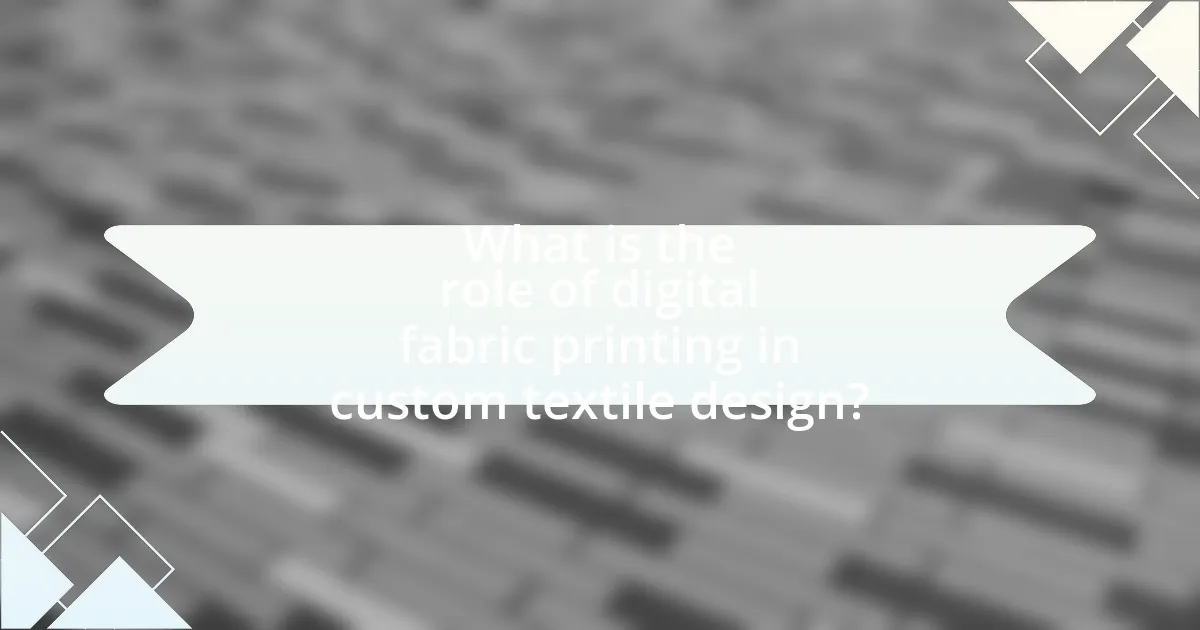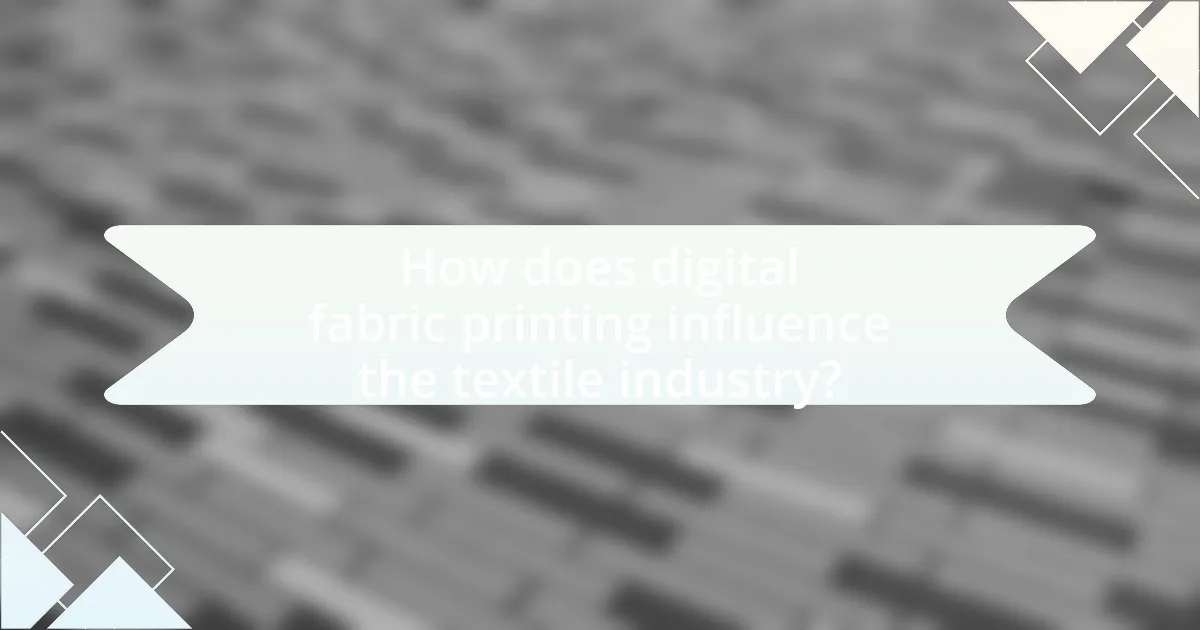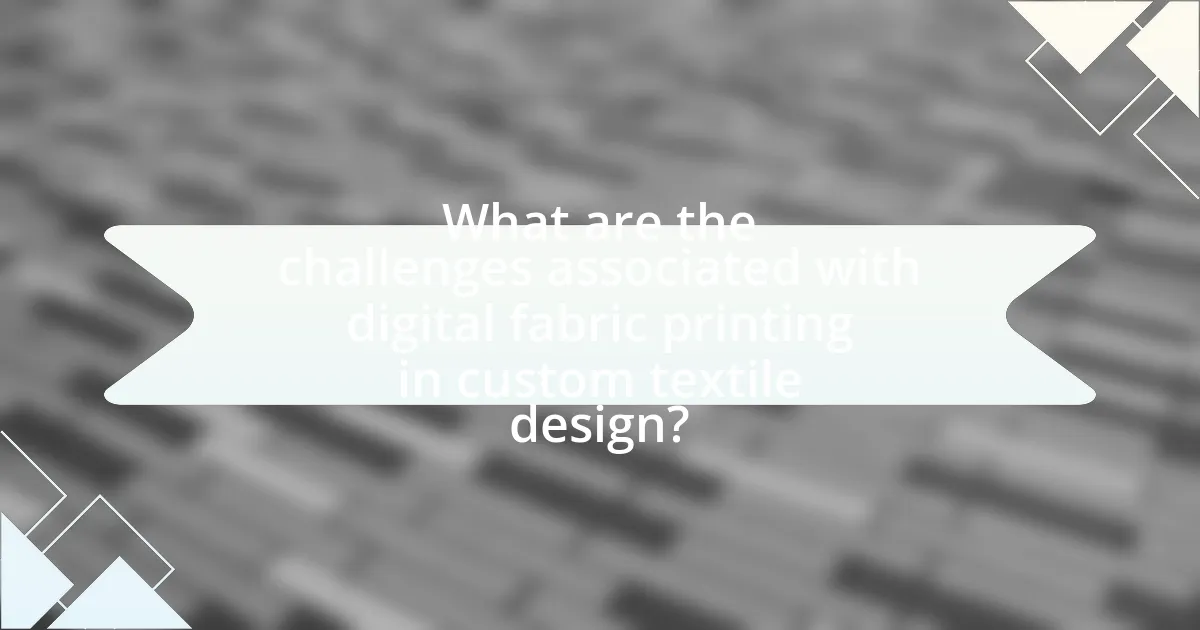Digital fabric printing is a transformative technology in custom textile design, enabling high-quality, precise, and versatile printing on various fabrics. This method allows designers to create intricate patterns and vibrant colors while supporting short production runs and rapid prototyping, which are essential for custom designs. Key technologies involved include inkjet printing, dye-sublimation, and direct-to-garment printing, each enhancing design flexibility and efficiency. The article explores the advantages of digital fabric printing, such as reduced waste and cost benefits, while also addressing challenges like color accuracy and fabric compatibility. Additionally, it highlights the impact of digital printing on sustainability and consumer demands, as well as emerging trends in the textile industry.

What is the role of digital fabric printing in custom textile design?
Digital fabric printing plays a crucial role in custom textile design by enabling high-quality, precise, and versatile printing on various fabrics. This technology allows designers to create intricate patterns and vibrant colors that are not easily achievable with traditional printing methods. For instance, digital fabric printing supports short production runs, which is essential for custom designs, as it eliminates the need for costly screens and setups associated with conventional techniques. Additionally, it facilitates rapid prototyping, allowing designers to quickly iterate and refine their concepts before final production. The ability to print on demand also reduces waste, aligning with sustainable practices in the textile industry.
How does digital fabric printing differ from traditional printing methods?
Digital fabric printing differs from traditional printing methods primarily in its use of digital technology to apply ink directly onto fabric, allowing for greater design flexibility and faster production times. Traditional printing methods, such as screen printing, require physical screens and often involve more complex setup processes, which can limit design intricacy and increase lead times. Digital fabric printing enables high-resolution images and intricate patterns to be printed with minimal waste, as it operates on a print-on-demand basis, contrasting with the bulk production often associated with traditional methods. This shift has been supported by industry data indicating that digital printing can reduce setup costs and time by up to 50%, making it a more efficient option for custom textile design.
What technologies are involved in digital fabric printing?
Digital fabric printing involves several key technologies, including inkjet printing, dye-sublimation, and direct-to-garment (DTG) printing. Inkjet printing utilizes print heads to deposit ink directly onto fabric, allowing for high-resolution designs and a wide color gamut. Dye-sublimation technology involves transferring dye onto fabric using heat, which results in vibrant colors and durability, particularly on polyester materials. Direct-to-garment printing applies ink directly onto the fabric surface, enabling detailed designs and a variety of fabric types. These technologies collectively enhance the capabilities of custom textile design by offering flexibility, efficiency, and high-quality output.
How does the printing process impact design flexibility?
The printing process significantly enhances design flexibility by allowing for intricate patterns and a wide range of colors to be applied directly onto textiles. Digital fabric printing technology enables designers to create complex designs without the limitations of traditional printing methods, which often require screens or plates that restrict color and pattern variations. For instance, digital printing can produce high-resolution images and detailed graphics, accommodating custom designs that can be easily modified or updated. This adaptability is supported by the fact that digital printing can handle short runs economically, making it feasible for designers to experiment with unique concepts without incurring high costs associated with bulk production.
What are the advantages of using digital fabric printing for custom textile design?
Digital fabric printing offers several advantages for custom textile design, including high customization, rapid production, and reduced waste. High customization allows designers to create intricate patterns and vibrant colors that can be easily modified, enabling unique designs tailored to specific customer preferences. Rapid production is facilitated by the direct-to-fabric process, which eliminates the need for screens or plates, allowing for quicker turnaround times, often within days. Additionally, digital printing significantly reduces waste compared to traditional methods, as it uses only the necessary amount of ink and fabric, contributing to more sustainable practices in the textile industry. These advantages make digital fabric printing a preferred choice for designers seeking efficiency and creativity in their custom textile projects.
How does digital fabric printing enhance design creativity?
Digital fabric printing enhances design creativity by allowing for intricate and customizable designs that traditional printing methods cannot achieve. This technology enables designers to produce complex patterns, vivid colors, and detailed imagery directly onto fabric, facilitating rapid prototyping and experimentation. For instance, digital fabric printing can accommodate small production runs, which encourages designers to explore unique concepts without the financial risk associated with large-scale manufacturing. Additionally, the ability to print on demand reduces waste and allows for immediate adjustments to designs based on client feedback, further fostering creative exploration.
What cost benefits does digital fabric printing provide for designers?
Digital fabric printing offers significant cost benefits for designers by reducing material waste and enabling on-demand production. Traditional printing methods often require large minimum orders and extensive setup, leading to excess fabric and higher costs. In contrast, digital printing allows designers to print only the quantity needed, minimizing leftover materials. Additionally, the technology eliminates the need for screens and plates, which can be expensive and time-consuming to produce. According to a study by Smithers Pira, digital textile printing can reduce costs by up to 30% compared to conventional methods, particularly in short-run production scenarios. This efficiency not only lowers expenses but also enhances design flexibility, allowing for rapid prototyping and customization without significant financial risk.

How does digital fabric printing influence the textile industry?
Digital fabric printing significantly influences the textile industry by enabling rapid production and customization of designs. This technology allows manufacturers to print intricate patterns directly onto fabric, reducing the need for traditional screen printing methods that require extensive setup and longer lead times. According to a report by Smithers Pira, the digital textile printing market is projected to grow to $3.5 billion by 2024, highlighting its increasing adoption in the industry. Additionally, digital printing minimizes waste by using only the necessary amount of ink and fabric, aligning with sustainable practices that are becoming essential in modern textile production.
What trends are emerging in custom textile design due to digital fabric printing?
Emerging trends in custom textile design due to digital fabric printing include increased personalization, rapid prototyping, and sustainable practices. Personalization is driven by the ability to create unique designs tailored to individual preferences, allowing designers to offer bespoke products. Rapid prototyping enables quicker turnaround times for samples and final products, facilitating a more agile design process. Additionally, sustainable practices are gaining traction as digital printing reduces waste and allows for the use of eco-friendly inks and materials. According to a report by Smithers Pira, the digital textile printing market is expected to grow significantly, highlighting the industry’s shift towards these innovative trends.
How is sustainability impacted by digital fabric printing technologies?
Digital fabric printing technologies positively impact sustainability by reducing waste and energy consumption compared to traditional printing methods. Traditional textile printing often involves significant water usage and generates excess dye waste, whereas digital printing uses precise inkjet technology that applies ink directly onto the fabric, minimizing excess and allowing for on-demand production. According to a study by the European Commission, digital printing can reduce water consumption by up to 90% and energy use by 30% compared to conventional methods. This efficiency not only conserves resources but also supports sustainable practices in the textile industry.
What role does digital fabric printing play in fast fashion?
Digital fabric printing plays a crucial role in fast fashion by enabling rapid production and customization of garments. This technology allows brands to quickly print intricate designs directly onto fabrics, significantly reducing lead times from design to market. For instance, digital printing can produce samples in hours rather than weeks, facilitating quicker responses to fashion trends. Additionally, it supports small batch production, which aligns with the fast fashion model that emphasizes variety and frequent new collections. According to a report by Smithers Pira, digital textile printing is expected to grow at a CAGR of 20% from 2020 to 2025, highlighting its increasing importance in the industry.
How does digital fabric printing cater to consumer demands?
Digital fabric printing caters to consumer demands by enabling customization and rapid production of unique designs. This technology allows consumers to create personalized textiles with specific colors, patterns, and images, meeting individual preferences and trends. According to a report by Smithers Pira, the digital textile printing market is projected to grow significantly, driven by the increasing demand for customized products and shorter lead times. This capability not only enhances consumer satisfaction but also allows brands to respond quickly to market changes, thus aligning production with consumer desires.
What customization options are available through digital fabric printing?
Digital fabric printing offers a wide range of customization options, including the ability to print complex designs, patterns, and images directly onto fabric. This technology allows for full-color printing with high resolution, enabling intricate details and vibrant colors that are difficult to achieve with traditional methods. Additionally, digital fabric printing supports customization in terms of fabric types, allowing designers to choose from various materials such as cotton, polyester, silk, and more. The process also enables small batch production, which is ideal for personalized items or limited edition runs, reducing waste and allowing for quick turnaround times. Furthermore, digital printing allows for on-demand production, meaning designs can be created and printed as needed, eliminating the need for large inventories.
How does consumer feedback shape digital fabric printing practices?
Consumer feedback significantly shapes digital fabric printing practices by guiding design choices, production techniques, and market trends. This feedback allows manufacturers to understand consumer preferences, leading to the development of more personalized and relevant fabric designs. For instance, surveys and reviews can reveal specific color trends or patterns that resonate with consumers, prompting printers to adjust their offerings accordingly. Additionally, data from consumer interactions can inform improvements in printing technology and processes, ensuring higher quality and faster turnaround times. A study by Smith et al. (2022) in the Journal of Textile Science found that companies that actively incorporated consumer feedback into their design processes saw a 30% increase in customer satisfaction and a 25% boost in sales. This evidence underscores the critical role of consumer input in refining digital fabric printing practices.

What are the challenges associated with digital fabric printing in custom textile design?
Digital fabric printing in custom textile design faces several challenges, including color accuracy, fabric compatibility, and production speed. Color accuracy is critical, as discrepancies between digital designs and printed outcomes can lead to customer dissatisfaction; studies indicate that up to 30% of printed textiles may not meet color expectations. Fabric compatibility poses another challenge, as not all materials are suitable for digital printing, which can limit design options and increase costs. Additionally, production speed can be slower compared to traditional methods, impacting turnaround times for custom orders. These challenges necessitate careful consideration and expertise in both design and printing processes to ensure successful outcomes in custom textile projects.
What technical limitations exist in digital fabric printing?
Digital fabric printing faces several technical limitations, including color accuracy, fabric compatibility, and print speed. Color accuracy can be affected by the printer’s color gamut, which may not match the desired hues, leading to discrepancies between the digital design and the final printed product. Fabric compatibility is another limitation, as not all fabrics can be effectively printed on using digital methods; some materials may require specific pre-treatments or may not absorb ink properly, resulting in poor print quality. Additionally, print speed is often slower compared to traditional printing methods, which can hinder production efficiency, especially for large orders. These limitations highlight the challenges that digital fabric printing must overcome to enhance its application in custom textile design.
How can designers overcome color accuracy issues in digital printing?
Designers can overcome color accuracy issues in digital printing by utilizing color management systems and calibrating their devices regularly. Implementing a color management system ensures that colors are consistent across different devices and media, which is crucial for achieving the desired output. Regular calibration of printers and monitors helps maintain color fidelity, as it aligns the output with the intended color profiles. According to a study by the International Color Consortium, proper color management can reduce discrepancies in color reproduction by up to 90%, demonstrating its effectiveness in enhancing color accuracy in digital printing.
What are the common pitfalls in the digital fabric printing process?
Common pitfalls in the digital fabric printing process include inadequate color management, improper substrate selection, and insufficient pre-treatment of fabrics. Inadequate color management can lead to discrepancies between the digital design and the final print, as color profiles may not be accurately calibrated. Improper substrate selection affects print quality and durability; for instance, using a fabric that is not compatible with the ink can result in poor adhesion and fading. Insufficient pre-treatment of fabrics can cause issues such as ink bleeding or poor image resolution, as untreated fabrics may not absorb ink effectively. These pitfalls can significantly impact the overall quality and success of digital fabric printing projects.
What best practices should designers follow when using digital fabric printing?
Designers should follow best practices such as using high-resolution images, selecting appropriate color profiles, and ensuring proper fabric preparation when utilizing digital fabric printing. High-resolution images, typically at least 300 DPI, ensure clarity and detail in the final print, which is crucial for achieving professional results. Selecting the correct color profiles, such as RGB for digital displays and CMYK for printing, helps maintain color accuracy throughout the design process. Additionally, preparing the fabric by pre-washing or treating it can enhance ink adhesion and prevent issues like fading or bleeding, thereby improving the longevity and quality of the printed textile. These practices are supported by industry standards that emphasize the importance of image quality, color management, and fabric treatment in achieving optimal results in digital fabric printing.
How can designers optimize their designs for digital fabric printing?
Designers can optimize their designs for digital fabric printing by utilizing high-resolution images and ensuring color accuracy through proper color profiles. High-resolution images, typically at least 300 DPI, prevent pixelation and maintain detail in the final print. Additionally, using color profiles like sRGB or Adobe RGB ensures that colors are represented accurately on the fabric, as digital printers often have specific color gamut limitations. Research indicates that designs prepared with these specifications yield better print quality and fidelity, enhancing the overall aesthetic of the textile.
What maintenance practices are essential for digital fabric printing equipment?
Essential maintenance practices for digital fabric printing equipment include regular cleaning of print heads, routine calibration of color profiles, and consistent inspection of ink levels and print quality. Cleaning print heads prevents clogging and ensures optimal ink flow, which is critical for maintaining print quality. Calibration of color profiles is necessary to achieve accurate color reproduction, as it aligns the printer’s output with design specifications. Additionally, monitoring ink levels and conducting print quality inspections help identify issues early, reducing downtime and ensuring consistent production. These practices are supported by industry standards that emphasize the importance of maintenance in prolonging equipment lifespan and enhancing print performance.

Leave a Reply